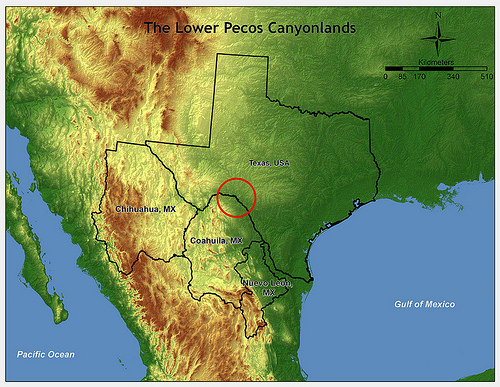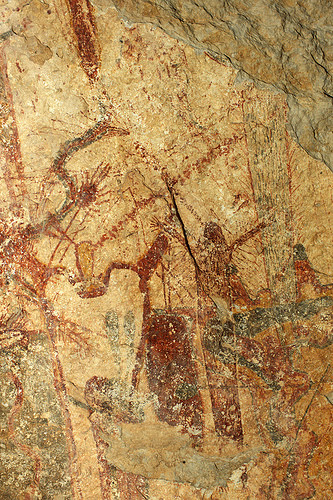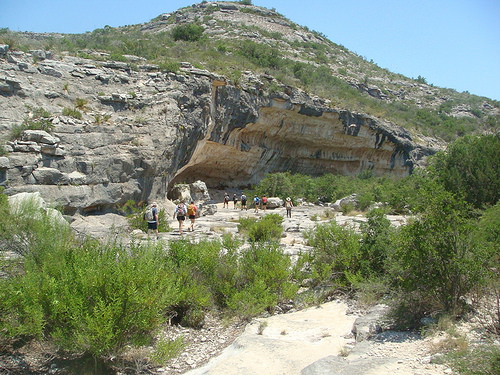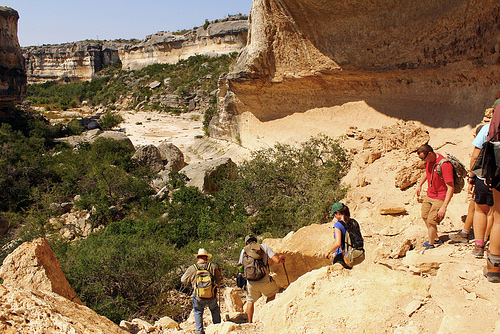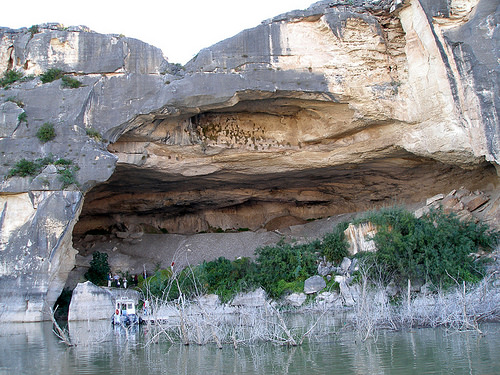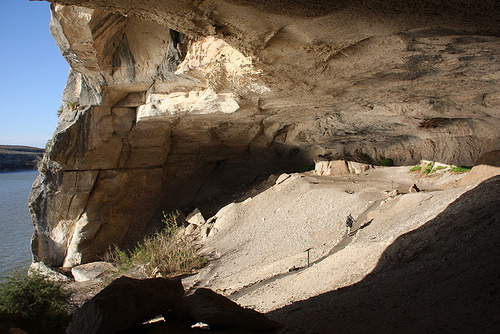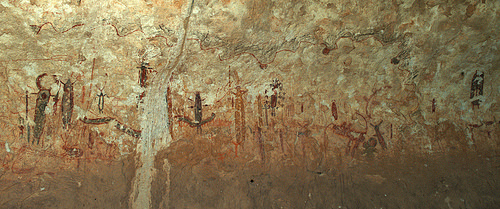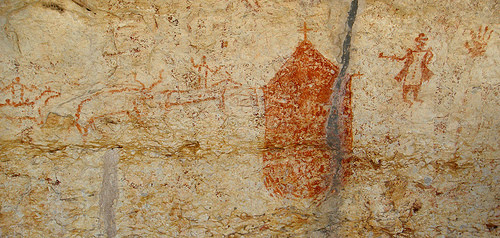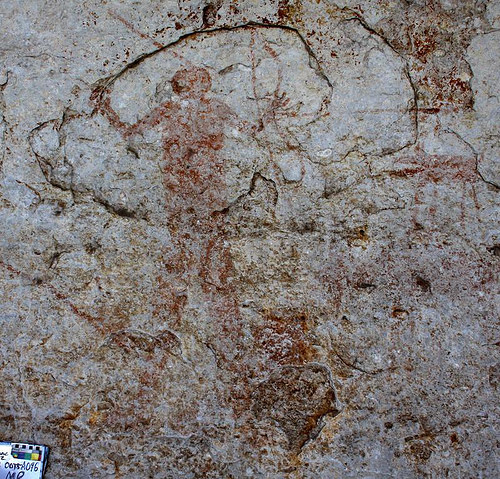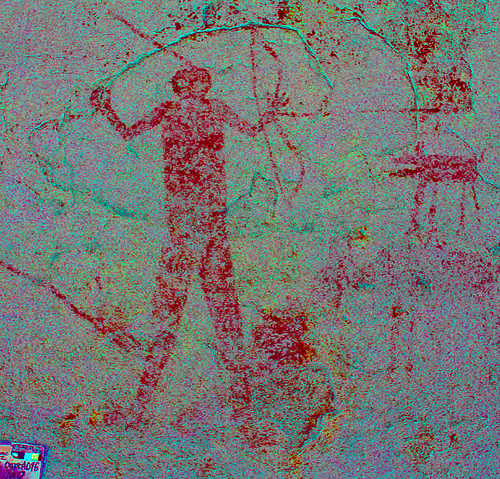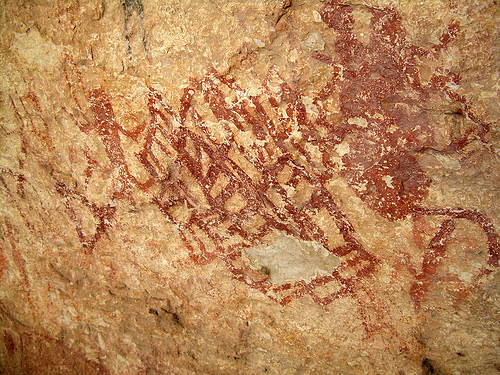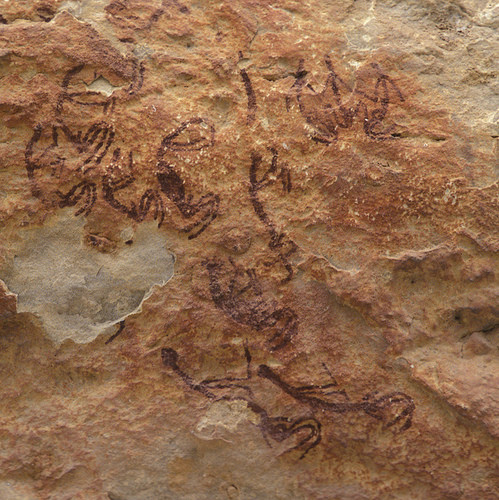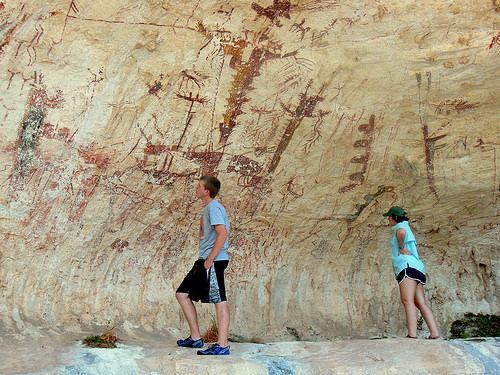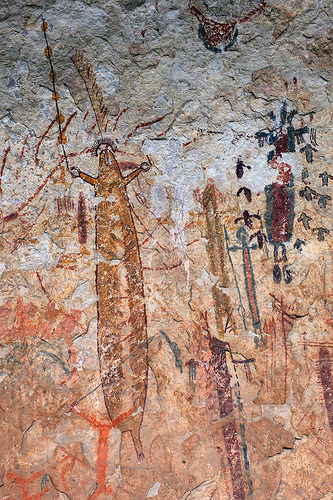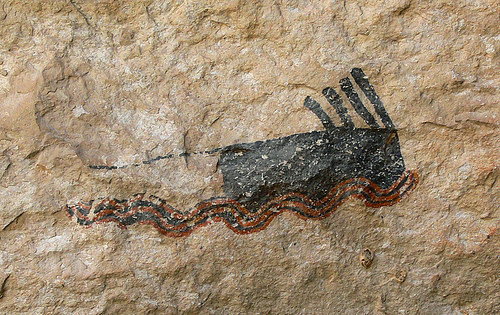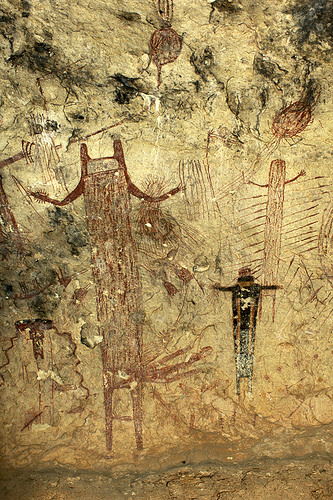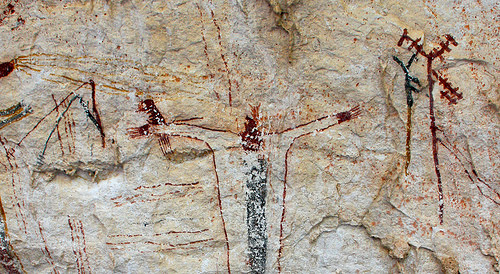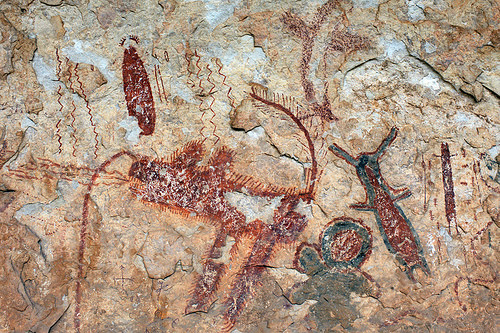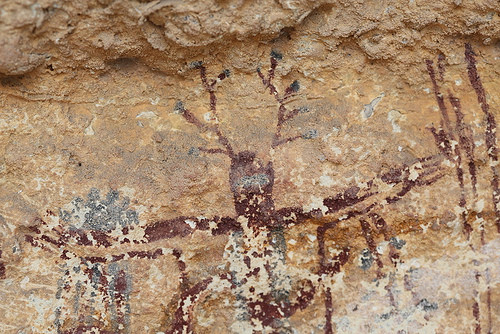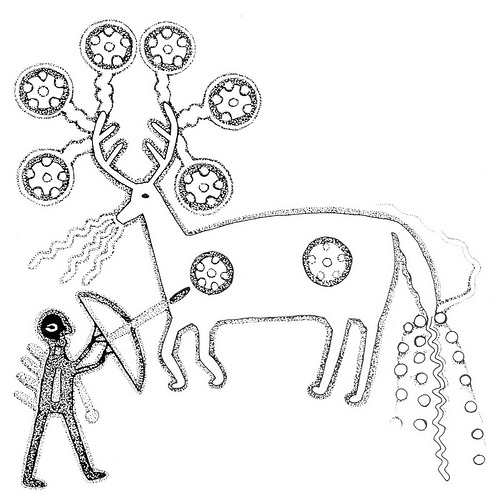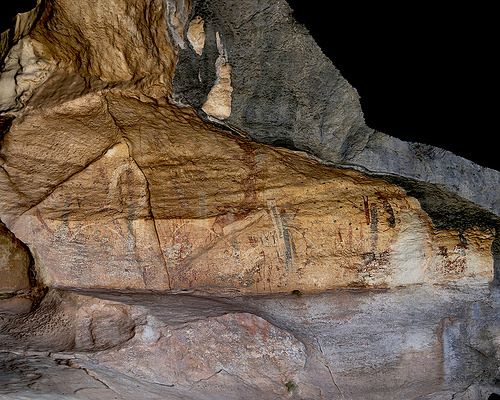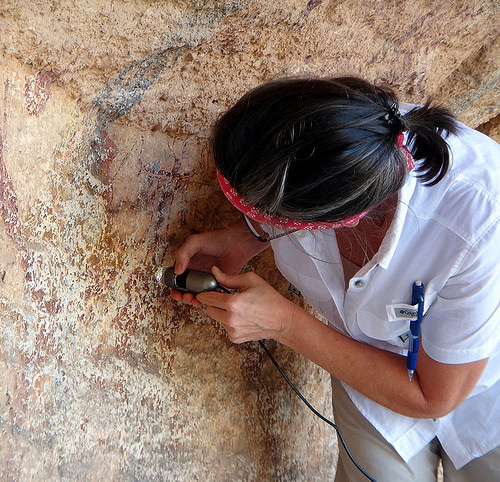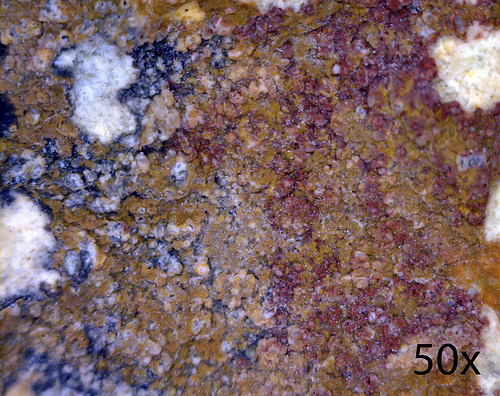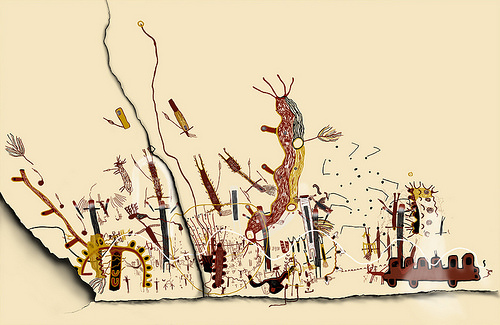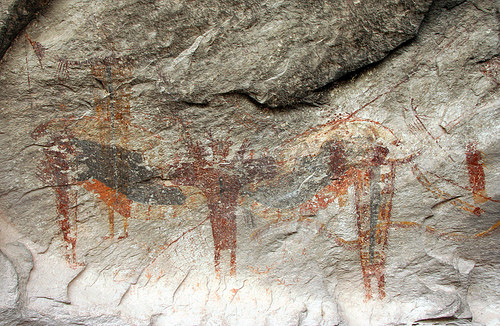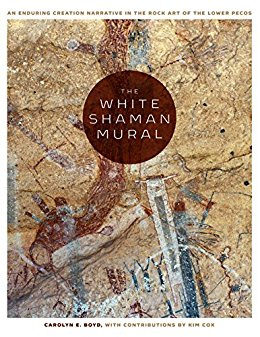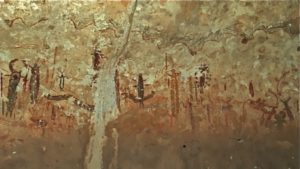
“Absolutely incredible” is a phrase repeated time and again as people gaze in awe at the majestic murals in the Lower Pecos Canyonlands. Whether one is an archeologist, lawyer, accountant, teacher or student, these ancient paintings elicit a similar response. Among rock art scholars, the complexity and compositional intricacies of Lower Pecos rock art are considered unrivaled on the global stage. Renowned French archaeologist Dr. Jean Clottes says, “It is my considered opinion—after having seen rock art on all the continents—the Pecos River rock art is second to none and ranks among the top bodies of rock art anywhere in the world.” The intrinsic value of the artistic record left behind by hunters and gatherers of the Lower Pecos thousands of years ago is incalculable.
The rough, rocky, arid country referred to as the Lower Pecos Canyonlands is centered upon the confluence of the Pecos River with the Rio Grande. This region extends approximately 100 miles north and south of the United States–Mexico border, and approximately 50 miles east and west of the confluence. The landscape is incised by deep, narrow canyons that slice through masses of grayish white limestone rock, remnants of a huge inland sea that covered the region during the Cretaceous period 100 million years ago. Wind and water erosion acting on the limestone substrate produced hundreds of rockshelters that provided refuge for prehistoric inhabitants. Groups of hunters and gatherers periodically occupied the rockshelters throughout the Holocene, leaving behind one of the best-preserved and longest records of Native American lifeways—11,000 years ago to the time of European contact. This is considered one of the most significant archaeological regions in the world.
Map of the Lower Pecos Canyonlands. (Map courtesy of Shumla Archaeological Research and Education Center).
________________________________________
Excavation of dry rockshelter deposits has yielded a wide assemblage of artifacts, such as wood and bone tools, matting, basketry, snares and the accumulated detritus of everyday living. Occasionally stone pipes and calcite crystals are found along with abundant chipped stone tools and grinding stones. Mobiliary art in the form of small painted pebbles and other painted objects such as wood, bone and snail shells are not uncommon in the dry shelters as are engraved stone plaquettes and freshwater mussel shells. Other artifacts include feather plumes, rasping sticks, fire-starting kits and medicinal and hallucinogenic plants such as peyote and datura.
Throughout prehistory, inhabitants of the Lower Pecos lived in small, mobile groups often referred to as bands. It isn’t unusual for people to think of these prehistoric hunters and gatherers as being vastly different from us, and in some ways they certainly were. They didn’t have agriculture, houses with central air and heat, cars, or the internet. They were, however, more like us than they were different. These were anatomically modern humans with the same cognitive capacity and capabilities as you and I today. They had the same brain that put a man on the moon. And, yes, they had a language—likely one with a vocabulary far richer than we can ever imagine to describe life, death, the land and the heavens. That they were socially well organized and intellectually capable is amply demonstrated in the archeological record, and the most compelling evidence comes from the elaborate, polychromatic murals painted on canyon and rockshelter walls (See the gallery at the end of this article).
The Painted Landscape
Pictographs are the most abundant form of rock art found in the Lower Pecos. These polychromatic paintings and drawings are made with mineral pigments and other natural ingredients, such as animal fat and plant juices. The paintings were applied to the rock surface using brushes made from animal hair, plant fibers, feathers, or fingers. Dry-applied pictographs are drawn on rock surfaces using pigment crayons or charcoal. Pictographs in the Lower Pecos have been categorized into five styles or classifications in a chronological sequence—Historic, Red Monochrome, Bold Line Geometric, Red Linear, and Pecos River.
Historic Period Rock Art
From northern Mexico to the canyons of Utah, artists of the Historic period captured initial contact with European culture in pictographic form. The rock art produced during this period demonstrated a preoccupation with domesticated animals, such as horses and cattle, churches, and the clothing and accoutrements of Spaniards. With the arrival of the Plains Indians into the region, such as the Apache, Kiowa, and Comanche, pictographs were executed in their Ceremonial and Early Biographical styles. Common themes include bison hunting, individual and group combat, weaponry, thunderbirds, dancing, horses, and figures with elaborate headdresses.
Red Monochrome Style
The Red Monochrome style began to be produced in the Lower Pecos Canyonlands sometime around 900 A.D. It is characterized by life-size images of humans and animals painted in varying shades of red. Rigid, human forms are solidly painted and portrayed frontally with their arms bent at the elbow, forearms raised, and legs apart. Red Monochrome animals are typically painted in profile and include realistic depictions of mountain lions, deer, turkeys, rabbits, dogs, and aquatic life, such as turtles and catfish. One of the most distinguishing characteristics of the Red Monochrome style is the portrayal of bows and arrows, an attribute that reinforces the placement of this style within the Late Prehistoric.
Bold Line Geometric
The least represented of the pictograph styles is referred to as Bold Line Geometric. It is characterized by bold, geometric designs, including zigzag, lattice, and herringbone patterns. Small human- and insect-like forms painted in deep red are the only figures that are not the characteristic geometric forms. It has been tentatively dated to the Late Prehistoric.
Red Linear Style
Red Linear style is typically characterized by animated, small, fine-lined figures of animals and humans. Most are only about 2 to 4 inches in length; some are as small as one-half inch. Their diminutive size has resulted in an under-appreciation for these intriguing paintings, as well as an under-estimation of the number of sites containing them.
There is tremendous diversity within the corpus of Red Linear imagery. Although some figures are rigid and static, others are quite fluid, evoking a sense of movement as humans engage in group activities, such as dancing, hunting, and possibly conflict. In addition to humans, pictographic elements include geometrics and animals, such as deer, canines, and rabbits. Both humans and animals are portrayed holding atlatls and fending sticks.
This style was believed to have been produced during the Late Archaic around 1,280 years ago after the Pecos River style, but prior to the Red Monochrome. Recently, however, we have identified numerous examples of Pecos River style rock art superimposing Red Linear style pictographs.
Pecos River Style
The vast majority of the rock art in the Lower Pecos Canyonlands, and that which sets it apart from all other rock art in the world, is referred to as Pecos River style. It is the most abundant, complex, and sophisticated of the regional rock art styles. In the early 1990s, chemists began collecting paint samples from seriously deteriorated Pecos River paintings for experimental radiocarbon dating. The dates obtained range from 4200±90 to 2750±50 RCYBP (radiocarbon years before present). If accurate, the 4200 year-old painting is the oldest dated pictograph in North America. In calendar years, this translates to approximately 2700 BCE.
Exquisite in detail and masterful in execution, the Pecos River style murals document myths, histories, and rituals of people living in the Lower Pecos Canyonlands thousands of years ago. They represent the oldest known “books” in North America. Artists of these paintings used an array of earth colors to create elaborate murals that are impressive in the level of skill required to produce them, as well as sheer size and complexity. Some of the panels are massive, spanning over 100 feet in length and 30 feet in height—dimensions requiring significant planning and construction of scaffolding and ladders. Other panels are quite small, tucked away in secluded alcoves high above the canyon floor.
It was long believed that these murals represented numerous painting episodes executed by different artists over hundreds or even thousands of years. Although over-painting exists, through detailed analysis of these panels, we now know that most are not a random collection of images painted over the course of time, but rather well-ordered compositions, planned arrangements of elements in a work of art to communicate an idea. Lower Pecos artists used pigment crayons or pieces of ochre to sketch out and organize the elements of their compositions. Vestiges of these preliminary sketches still can be seen today.
The artistic merit and compositional quality of the panels were noted by the early pioneers in Lower Pecos rock art recording. Forrest Kirkland observed that the rock art “communicates a sense of color harmony unsurpassed by painters of our own time” and arranged so perfectly on the wall that “to move a single important element would seriously injure their delicate balance and detract from their artistic merit.”
The geographic boundaries of the Pecos River style, although not clearly defined, appear to center on the confluence of the Pecos River with the Rio Grande and extend about 100 miles in all directions. In Texas, most are located along the Pecos, Devils, and Rio Grande canyons and their tributary systems. Sites in Coahuila, Mexico, are also predominantly confined to well-watered canyons and their tributaries.
Pictographic elements included in the Pecos River style murals include anthropomorphs or human-like figures, animals, a wide range of geometric imagery, and enigmatic, fantastic creatures that are not identifiable as human or animal. Anthropomorphs are by far the most frequently depicted element. Although these figures share many common characteristics, such as elongated, rectangular bodies with disproportionally short arms and legs, there is an incredible amount of diversity within what is called “Pecos River style anthropomorphs.”
Although most anthropomorphs range in size between 3 to 7 feet, some are monumental, towering over 20 feet in height. Others are pocket-sized; the smallest recorded Pecos River style anthropomorph is only 3 inches tall. These fascinating figures are often finely executed in red, yellow, black, and white. Yet, many are painted in only one color and far less elaborate. Not only is there variability in the form and color of these figures, but also in the accoutrements and paraphernalia depicted with them. Headdresses of varying types, clusters of feathers at the waist, and wrist or elbow tassels often adorn these human-like figures. Generally the artists portray anthropomorphs wielding paraphernalia, such as atlatls, spears, and staffs. The atlatl and spear are usually linked to the right hand of the figure; feathered darts, rabbit sticks, and staffs are linked to the left hand. But sometimes none of these items are present or they are associated with the opposite hand.
Animals are portrayed in the Pecos River style paintings. Deer and felines are the most common; birds and canines to a lesser degree. Some imagery resembles insects, such as caterpillars, dragonflies, and moths or butterflies. Sinuous, snake-like figures are also portrayed in the rock art.
Understanding the Meaning and Process
Why did artists thousands of years ago spend time, energy, and resources in the production of these enigmatic panels?
Beginning in the 1950s, researchers suggested that perhaps the art represented a hunting cult or medicine society. Shortly after, the elaborately portrayed anthropomorphic figures were identified as shamans, the intermediaries between the human and spirit world. It wasn’t long before the term “shaman” became a catchall for all Pecos River anthropomorphs. By the late 1980s, it was generally accepted that any attempt to interpret Pecos River rock art, beyond shamanism, would be at best speculative. The obstacles faced by archaeologists attempting to interpret the art seemed almost insurmountable. The mantra heard time and again was that “the meaning of the art was lost with the people who produced it.”
Patterns………..
Although the artists of the Lower Pecos are gone, their myths and belief systems have endured in the shared symbolic language of the native peoples living today. Actors and details may change, but basic story lines and concepts persist. This shared symbolic world is exemplified in the ancient rock art of the Lower Pecos, and the key to unlocking these visual texts is not lost. Just as forensic detectives look for patterns to solve crimes and cryptologists look for patterns to break secret codes, archeologists look for patterns to interpret rock art. We begin by documenting the rock art panel in detail, capturing each pictographic element, the attributes of that element, and its contextual relationship to other imagery in the panel. This allows us to identify variation and consistency in artistic styles, recurring patterns, and anomalies in the art.
One of the most ubiquitous patterns we have identified combines antlered anthropomorphs with dots on the tips of their antler tines; spear-impaled deer, and dots or circles that also are impaled. To understand the meaning of this pattern, we compared patterns in the rock art with similar patterns in myths and iconographies of many Mesoamerican groups. Almost immediately we found notable parallels with the myths of the Huichol Indians of Mexico, as well as other Uto-Aztecan speaking peoples. This pattern led us to the identification of not only ritual practices involving the use of the sacred peyote cactus, but to mythological characters and deities associated with the origins of peyote and the birth of the Sun. Ultimately, we were led to identifying one of the most famous murals in the region—White Shaman Shelter—as a pictorial creation narrative, perhaps the oldest in North America. But how could we know that this 24-foot-long rock art panel was painted as a single composition?
…………and Process
Patterns provide clues to “what” the rock art means. But to get at the “how” requires an examination of the technical history of a rock art panel—how the mural was painted. Through documentation and analysis of the sequential ordering of motifs, we have begun to gain insights into deeper layers of meaning—the artistic and cognitive processes that led to the creation of the art.
Our most recent discoveries about the operational sequence of the art was truly groundbreaking and, frankly, mind-boggling. We began producing layered, digital illustrations of Pecos River style murals using Adobe Photoshop and a Wacom Cintiq Interactive Pen Display. Using a digitizing stylus directly on the Cintiq screen, we digitally applied the paint layer by layer to reproduce the original painting sequence. The challenge, however, was identifying the paint layers. Hand lenses, macro photography, and magnifiers proved inadequate. We needed greater magnification, and we needed to be able to photograph what we were seeing at that level of magnification. I shared our frustration with a colleague, Mark Willis, who has an uncanny ability to find cost effective solutions to technological problems. Sure enough, this was no exception. He introduced us to the Dino-Lite Pro handheld digital microscope with 20X to 220X magnification.
With this tool we returned to the field to capture digital images of microscopic areas within Pecos River murals. And much to our surprise and delight, we were able to confidently and objectively identify painting sequences for almost all figures in the panels. The results were startling. At the sites studied thus far, we could see that the mural artists painted all black imagery first, followed by red, then yellow, then white. Strict rules governed the order in which the paint was applied. Black superimposed black. Red superimposed black. Yellow superimposed red and black, while white superimposed all colors. Identifying the order in which the artist applied paint, color-by-color, figure-by-figure, provided irrefutable evidence that the murals analyzed were indeed single compositions, pictorial narratives.
As an artist and an archaeologist, I have long recognized the extraordinary complexity of Pecos River style rock art. When I first began studying the rock art of the Lower Pecos 20 years ago, my goal was to see if it was even possible to talk about its “meaning” in a meaningful context. However, I have come to realize that the true significance of the art does not exist independently of its organizing structure. Our greatest challenge is not in deciphering the meaning of rock art; it is in recognizing the overriding principles that provided the framework for understanding its meaning and governing its production.
Our analysis confirmed that the murals in many cases, if not all, were planned compositions with rules governing not only the portrayal of symbolic forms, but also the sequencing of colors. Complex images painted in black, red, yellow, and white were woven together to form intricate pictorial narratives. As with the Mesoamerican codices, everything has inherent meaning. Nothing is arbitrary or random, including the order in which the paint is applied. That inherent meaning is part of a larger structural meaning directly relating to and arising out of an earlier culture and fits into a broader continuum that persisted into later cultures in Mesoamerica and the American Southwest. It is a continuum that has led to our interpretation of the murals as visual narratives detailing stories of creation, the birth of the sun and beginning of time.
Guided tours to some of the region’s most spectacular rock art sites are provided by Seminole Canyon State Park and Historic Site (www.tpwd.state.tx.us/state-parks/seminole-canyon) and the Rock Art Foundation (www.rockart.org).
____________________________
For those interested in learning more about the Lower Pecos story, a new publication entitled Painters in Prehistory: Archaeology and Art of the Lower Pecos Canyonlands, edited by Harry J. Shafer, can be obtained at http://tupress.org/books/painters-in-prehistory.
Recommended Reading
Boyd, C. E. 2003 Rock Art of the Lower Pecos. Texas A&M University Press, College Station.
Kirkland, F. and W. W. Newcomb 1967 The Rock Art of Texas Indians. University of Texas Press, Austin.
Shafer, H. J. 1986 Ancient Texans. Texas Monthly Press, Austin.
Painters in Prehistory: Archaeology and Art of the Lower Pecos Canyonlands, 2013 edited by Harry J. Shafer. Trinity University Press, San Antonio.
Zintgraff, J., and S. A. Turpin 1991 Pecos River Rock Art: A Photographic Essay. Sandy McPherson Publishing Company, San Antonio, Texas.
_________________________________________________________________________________________
Supplement
Studying and Documenting the Pecos River Record
First Encounters
In 1849, Captain S.G. French reported seeing Indian paintings near the mouth of the Pecos River, but it was not until the 1930s that serious efforts at recording and studying the art of the region began. These early recording efforts were undertaken by truly remarkable individuals. In 1931, two adventurous women, Emma Gutzeit and Mary Virginia Carson from the Witte Museum in San Antonio, recorded 18 rock art sites, producing watercolor renderings of what they saw.
A few years later, Kirkland, a commercial draftsman, and his wife, Lula, began producing detailed and incredibly accurate watercolor renderings of the major sites in Texas. It was the realization that many of the paintings were being “mutilated and destroyed” that prompted the couple to begin this massive undertaking. Before Kirkland’s untimely death in 1942, he managed to copy 43 rock art panels in the Lower Pecos Canyonlands. Twenty-five years after Kirkland’s death, W. W. Newcomb wrote The Rock Art of Texas Indians, showcasing Kirkland’s beautiful illustrations and acknowledging the contribution made by Kirkland: “He had attempted what no one else had dared, and he had succeeded beyond the dreams of any. He had copied most of the rock art then known in Texas. His heroic, self-imposed task was completed.”
Archaeologist and author A. T. Jackson also documented rock art sites in Texas in the 1930s. He referred to the Lower Pecos as the “premier pictograph area of the state.” Recognizing the incredible value of these paintings, he launched an intensive rock art documentation project. In his book,The Picture Writing of Texas Indians, he wrote “. . . the rapid destruction of these first works of art and specimens of early writing in Texas creates a crying need for action. . .” to document and preserve the art for future generations.
Recent Efforts
Recognizing the importance of the region and its resources, the Witte Museum of San Antonio, Texas initiated an interdisciplinary effort to study and publicize prehistoric art of the Lower Pecos region in the early 1980s. Drawing on the skills of not only archaeologists, but archaeobotanists, art historians, and social anthropologists, the Witte effort sought to interpret the material culture and investigate the lifestyle of the prehistoric hunter-gatherer inhabitants of the Lower Pecos Canyonlands. Their endeavors resulted in the “Ancient Texans” exhibit at the Museum and the publication of Ancient Texans: Rock Art and Lifeways along the Lower Pecos by Harry Shafer and Jim Zintgraff. It also led to a significant increase in public awareness of prehistoric art and a greater understanding of the hunting-gathering lifeways of the people who produced the art. Out of this effort came the creation of the Rock Art Foundation to promote and preserve the region’s rock art. The Witte’s commitment to stewardship of the region and its resources is ongoing. Painters in Prehistory: Archaeology and Art of the Lower Pecos Canyonlands, edited by Harry Shafer, was recently published in association with the Witte Museum and will serve as the text accompanying their new Lower Pecos exhibition.
Two significant documentation projects also have been launched. A group of dedicated volunteers with The Texas Archeological Society formed a Rock Art Recording Task Force to document rock art sites across Texas. And, for more than a decade, Shumla Archaeological Research and Education Center (www.shumla.org), a nonprofit organization located in the Lower Pecos, has been engaged in the most intensive rock art recording project undertaken in the region, the Lower Pecos Rock Art Preservation Initiative. The goal of this project, for which I am the Principal Investigator, is to create a permanent visual and textual archive for present and future generations and to promote rock art preservation through education.
In 1989, my first efforts to document the murals began with the simple tools of an artist. Now, after years of intensive field work with my colleagues at Shumla, I have incorporated into our investigations 3D laser mapping, SfM photography, portable X-ray fluorescence, Dino-Lite handheld microscopes, robotic total data stations, and Wacom Cintiq Interactive Pen Displays. As new technologies become available, we return to sites to capture more data, and each visit is rewarded with new discoveries.
Carolyn Boyd
__________________________________
GALLERY
ROCK ART OF THE LOWER PECOS CANYONLANDS
Above: The panel at Rattlesnake Canyon reveals the complexity of Pecos River style images and the challenges of recording and interpretation. (Photograph courtesy of Jean Clottes)
Large rock shelters such as this one above at Cedar Springs provided both refuge and limestone canvases for documenting pictographic narratives. (Photograph courtesy of Shumla Archaeological Research and Education Center).
Above: Eagle Nest Canyon in Langtry, Texas. (Photograph courtesy of Nataliya Chemayeva.)
Above and below: Parida Cave is located along the Rio Grande and houses deeply stratified deposits, as well as Pecos River style rock art. In the late 1800s this site was referred to as Parida Cave Station and served as a railroad stop for passengers traveling across the country on the Southern Pacific Railroad. Although now only accessible by boat, once inside the shelter’s expansive interior visitors can take advantage of more than 300 feet of designated trails. (Photograph courtesy of Shumla Archaeological Research and Education Center).
Halo Shelter is located in tributary canyon of the Devils River. Pecos River style pictographs painted in red, yellow, black, and white span almost 100 feet along the wall of this shelter. This photograph represents the best preserved portion of the mural. (Photograph courtesy of Jean Clottes).
Vaquero Shelter is located in Seminole Canyon State Park and contains wonderful examples of Historic Period rock art. (Photograph courtesy of Shumla Archaeological Research and Education Center).
Anthropomorphs standing with their arms in a “stick ‘em up” position are characteristic of Red Monochrome paintings. This anthropomorph is wearing a single feather headdress and is wielding a recurved bow. (Photograph courtesy of Shumla Archaeological Research and Education Center).
DStretch, which uses decorrelation stretch, significantly enhances photographs of badly faded images. (Photograph courtesy of Shumla Archaeological Research and Education Center).
Bold Line Geometric imagery is characterized by bold geometric lines forming zigzag patterns and small human and insect-like figures, as shown here from Parida Cave along the Rio Grande. (Photograph courtesy of Shumla Archaeological Research and Education Center).
Fluidly painted, tiny Red Linear style figures convey a sense of movement and ceremony in this panel located in Presa Canyon. Each figure in this photograph is less than 5 inches tall. Males are portrayed with an erect phallus and women are sometimes portrayed wearing “skirts.” (Photograph courtesy of Rupestrian Cyberservices).
Most Pecos River style imagery is well beyond reach of the shelter floor. Use of scaffolding to paint the murals demonstrates a significant investment by ancient artists in time, effort and resources. (Photograph courtesy of Shumla Archaeological Research and Education Center).
This finely executed yellow and red Pecos River style anthropomorph from Halo Shelter is portrayed with a feather headdress and is wielding a staff. The small halo-like arch located just above the head of this figure is characteristic of many anthropomorphs at this site. Three vertical lines located on the forehead of the figure may represent tattooing. Note the claw- or pincher-like hands. Just below and to the right of this figure is an antlered anthropomorph with black dots on its antler tines. This is a recurring motif in Pecos River rock art. (Photograph courtesy of Jean Clottes).
Pecos River style rock art contains a vast array of enigmatic imagery. (Photograph courtesy of Shumla Archaeological Research and Education Center).
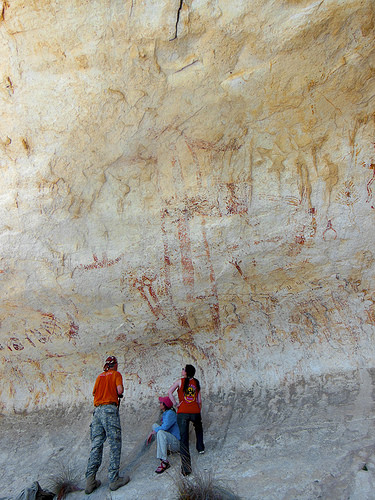 At almost 20 feet in height, this Pecos River style anthropomorph is one of the tallest figures in the Lower Pecos. (Photograph courtesy of Shumla Archaeological Research and Education Center).
At almost 20 feet in height, this Pecos River style anthropomorph is one of the tallest figures in the Lower Pecos. (Photograph courtesy of Shumla Archaeological Research and Education Center).
_________________________________________________________________________________________
This large Pecos River style anthropomorph with a U-shaped head stands more than 10 feet in height and is portrayed with various accoutrements. Associated with its right hand is an atlatl and spear and with its left hand spears, staff, and a datura power bundle. The right wrist is depicted with some type of adornment and suspended from the left elbow is something resembling a pouch. At its mid-section are waist tassels and at the hip are a cluster of possible feathers. (Photograph courtesy of Shumla Archaeological Research and Education Center).
White Pecos River style anthropomorphic figures are striking and this is no exception. It has a bird-like head and wrist adornment. Red lines are interspersed within the white body and a wide black band runs vertically down its center. This figure is especially interesting because it is holding two atlatls in its right hand and two staffs in its left.(Photograph courtesy of Shumla Archaeological Research and Education Center).
Halo Shelter houses an unusual two-legged Pecos River style feline with piloerection (hair standing on end). The wavy lines coming out of its mouth may represent speech or breath. The solid red line being emitted out of its nose may represent blood or a stream of mucous, both of which have been reported as a potential side-effect of trance states induced through extreme physical exertion or the use of some hallucinogenic plants. (Photograph courtesy of Jean Clottes).
The antler tines of many antlered anthropomorphs found in Pecos River style rock art are tipped with black dots. The black dots represent the sacramental plant, peyote. (Photograph courtesy of Shumla Archaeological Research and Education Center).
Illustration of a Huichol yarn painting portraying the birth of peyote from the antlers and body of the Great Deer in Wirikúta. In Huichol religion, peyote and deer are an inseparable sacred symbol. Yarn painting by Chavelo González de la Cruz. (Illustration by Carolyn Boyd, courtesy of Texas A&M University Press).
____________________________________
3D photographic model produced using Structure from Motion (SfM) photogrammetry of the mural at White Shaman Shelter. (Photograph courtesy of Shumla Archaeological Research and Education Center).
Using a Dino-Lite handheld digital microscope, Boyd photographs a small section of the White Shaman mural to determine the order in which the paint was applied. (Photograph courtesy of Shumla Archaeological Research and Education Center).
In this microscopic photograph of a pea-sized section of the mural, the yellow paint can be seen overlying both the red and black paint and the red is over the black. This painting sequence held true throughout the entire mural. (Photograph courtesy of Shumla Archaeological Research and Education Center).
The White Shaman illustration was produced digitally using Adobe Photoshop on a Wacom Cintiq Interactive Pen Display. A separate layer was created in Photoshop for each figure and each color. In other words, if a figure is composed of three colors, it was reproduced according to its original painting sequence in three separate layers. The final rendering shown here is the combination of over 200 digital layers. (Illustration by Carolyn Boyd, courtesy of Shumla Archaeological Research and Education Center)
A winged, antlered anthropomorph with dots attached to its antler tines is part of a large, polychromatic composition at Fate Bell Shelter in Seminole Canyon State Park. (Photograph courtesy of Shumla Archaeological Research and Education Center).
_______________________________
Editor’s Note
Did you like this article? You may be interested in reading more about the White Shaman mural in Carolyn Boyd’s award-winning book, The White Shaman Mural.
_______________________________
____________________________________________
Subscribe to Popular Archaeology Premium. Available on all laptops and mobile devices, and still the industry’s best value at only $9.00 annually.
___________________________________________
Travel and learn with Far Horizons.
____________________________________________
This richly illustrated issue includes the following stories: Recent findings shedding new light on the whereabouts of the remains of Philip of Macedon, father of Alexander the Great; how an archaeologist-sculptor is bringing bones of the dead back to life; archaeologists uncovering town life at the dawn of civilization; an exclusive interview with internationally acclaimed archaeologist James M. Adovasio about what makes the Meadowcroft Rockshelter prominent in the ongoing search for the first Americans; what archaeologists are finding at the site of the ancient city of Gath, the home town of the biblical Philistine giant, Goliath; and how scientists are redrawing the picture of human evolution in Europe. Find it on Amazon.com.

